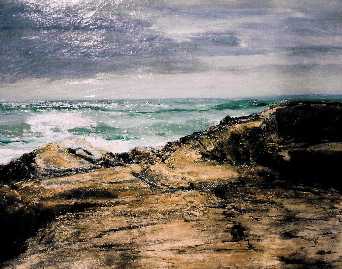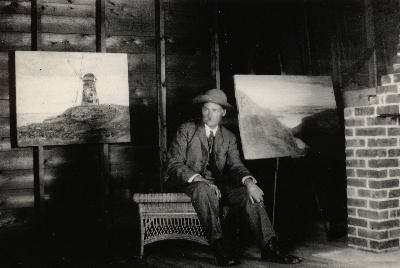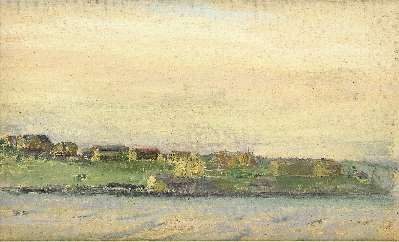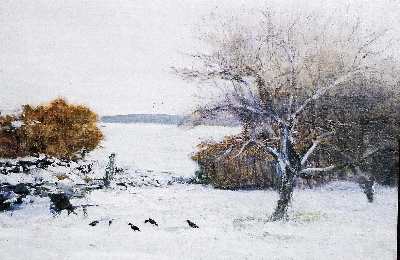Paris Salon Essays
Essay #4
The Artistic Career of Elijah Baxter (1849-1935) after Study in Europe
Fourth Weekly Essay on Paris Salons! As promised on the January show invitations, here is the fourth weekly
essay pertaining to the current exhibit.
The Artistic Career of Elijah Baxter (1849-1935) after Study in Europe
Essay by Catherine Bert
 Last
week the early life of Baxter was explored in Essay #3, now we continue with
his return to the United States. After three years abroad, Baxter was a well-trained
and independent painter. His early experiences in the European education
system marked his philosophy of art education throughout his life. First
and foremost however, Baxter was an ardent painter. He understood that he
needed to concentrate on his painting, sell his works and garner critical
acclaim if he were to fulfill his art destiny. When he returned to Rhode
Island in 1873, it was under stressful circumstances.
Last
week the early life of Baxter was explored in Essay #3, now we continue with
his return to the United States. After three years abroad, Baxter was a well-trained
and independent painter. His early experiences in the European education
system marked his philosophy of art education throughout his life. First
and foremost however, Baxter was an ardent painter. He understood that he
needed to concentrate on his painting, sell his works and garner critical
acclaim if he were to fulfill his art destiny. When he returned to Rhode
Island in 1873, it was under stressful circumstances.
The Sprague family in 1873 lost their fortune in the financial crashes that year necessitating the withdrawal of his educational support. Furthermore, Baxter, according to a 1905 account, had to take a moratorium on painting and put his full time energy into assisting in the Sprague crisis, ripe with marital and political scandal. Fred Burton’s 1905 account documents the event,
“For five years nearly there was no thought of art save as a memory and a hope. There is not need to recall in detail the tremendous tangle of litigation and scandal in which the Sprague’s were involved... the burdens Baxter undertook were remarkably heavy, especially when his years are considered. (Baxter was 23) As the governor was still in politics his private troubles became in great measure public affairs, and Baxter was as prominent politically as formerly he had been in the quiet realm of art.”
It was not until around 1877 that Baxter was able to seriously concentrate on his career without distraction. From exhibition dates and art reviews you can piece together three distinct clusters of art production from Baxter. The early period where he sought the network of Boston friends and contacts he made at Antwerp, the Providence market and then his move to Newport.
As early as 1874 Baxter is exhibiting in the Boston Art Club and by 1878 he won a coveted Boston Medal. Despite the artist organizations emerging in Providence, Baxter continued to work the Boston market. In 1881 he participated in the Massachusetts Charitable Mechanical Association exhibit. His young Rhode Island artist colleague Charles Stetson attended the exhibition and commented in his catalog that Baxter’s painting “Mediation” was “good”, high praise from this discriminating critic and artist who was not so kind to fellow Providence Art Club painter, John Salinger’s portrait. Stetson wrote, “The hands are poorly done.”
In 1880 Baxter gravitated to Old Warwick to live and paint. It is around this time there is a concentrated shift to exhibit in Providence, both in the commercial gallery market and the Providence Art Club. Baxter exhibited at the Westminster gallery FA Waterman, the Providence Art Club, Sheldon’s Auction and Bartons. His artistic production was impressive. In 1893 he exhibits 73 paintings for sale at Barton’s in Providence.
 In these early years he painted a myriad of subject matter from still life,
to landscape to figurative ideals. Chrysanthemums were one of his favorite
subject matters. He exhibited these in an 1895 Providence Art Club show and
also later in a Rhode Island School of Design show of Rhode Island artists
in 1903. The Providence Art Club purchased a still life of Roses for their
collection in 1891. His style uses very lush color, with the dark backgrounds
he became so fond of seeing among the Dutch painters abroad.
In these early years he painted a myriad of subject matter from still life,
to landscape to figurative ideals. Chrysanthemums were one of his favorite
subject matters. He exhibited these in an 1895 Providence Art Club show and
also later in a Rhode Island School of Design show of Rhode Island artists
in 1903. The Providence Art Club purchased a still life of Roses for their
collection in 1891. His style uses very lush color, with the dark backgrounds
he became so fond of seeing among the Dutch painters abroad.
A Providence Journal art critic wrote.
"A few flower pieces, notably some gorgeous chrysanthemums are fine
examples of rich coloring.”
A curious group of “ Greek Rustics” was also painted at this
time. These idealized works depicted toga clad women in the woods, showing
the influence of his academic exposure to classical themes as well as his
deft handling of the figure.
Baxter received ample praise for his figural work ...”
His work is well known to art lovers. Mr. Baxter is an artist of great force and originality. His paintings evidence a visual imagination and striking individuality, the conception being executed with great strength and facility.” Providence Journal...
Ironically, lacking the advantage of European training, the popular artist Charles Walter Stetson was likewise attracted to this very same subject matter throughout his career. Most of the paintings that you encounter today by Baxter are those of his landscapes and seascapes. His love affair with great outdoor painting in Antwerp continued throughout his entire career.
Building his “Tower” studio on Longmeadow Street in Old Warwick he found ample subject matter in the surrounding environs. These landscapes show his strong composition and loose, dreamy brushwork. Landscapes would only become secondary to seascapes for Baxter in 1912 when he sold his Warwick property and moved to Newport. He had high hopes of continued prosperity and good fortune in this rapidly expanding city of wealth. He helped found the Newport Art Association and secured a new patron, Henry Clews noted New York stockbroker with an estate on Ocean Drive.
Clews offered Baxter a studio on the grounds of the estate, permitting Baxter to paint the rugged rocks of the shore and moody ocean from a prime location every day. From 1912 onward Baxter’s exhibited primarily seascapes with such titles as: Drifting and Mackerael Fleet off Newport Then in 1928 his significant work, Fog Threatens was awarded the Providence Art Club Semi- Centennial prize.
 Critics
wrote...
Critics
wrote...
“ It is a sincere and satisfying canvas, solidly painted, especially the rocks in the foreground. Mr. Baxter has made a special study of the sea in its many phases and ...caught the atmosphere of a murky day with its sullen sea and clouds and the threat of the fog in the offering.” Providence Journal
Baxter’s old friend, S.R. Burleigh jotted this note to Elijah.
“ My dear Baxter, Congratulations on getting the Art Club Prize. It would
seem that the old guard has never surrendered nor died.”
Thus at the ripe old age of 70 Elijah Baxter demonstrated that he was a very
accomplished artist comparable to other noted American painters of his era.
But where Baxter was most unique among his fellow Rhode Island artists was
his uncanny ability to recognize and build a patronage among the wealthy
and influential in order to achieve his career objectives. While this was
the goal for many artists, often they tried and failed to find the necessary
patronage to support their careers among collectors. Charles Walter Stetson
would eventually leave the state because of the limited opportunities and
go on to achieve international fame abroad. Very few local artists cultivated
more than one or two art patrons and none achieved the depth and diversity
of admirers on the scale of Elijah Baxter.
His first major patron, the Sprague family secured him the distinct advantage of European training. His friendship with the wealthy and powerful Governor William Sprague is evident from his devoted service during the political, financial and marital fall out of the 1870’s. However, one postulates that it was William’s mother, Fanny, who first recognized Baxter’s magnetism and was influential in transforming the young artist into a polished and elegant society man. Something many would claim she was unable to achieve for her own son William. When sent abroad, the Sprague letters of introduction placed him in the midst of very sophisticated and educated European circles. Somewhat of an “Eliza Doolittle” character Baxter biographer, Burton in 1905, noted it.
“No American who ever went abroad as an art student fared as he did. He had the privilege of going substantially everywhere, and invitations poured in upon him beyond all possibility of acceptance without any regard whatever to his work. Instead of the bohemian life of the studio with its traditional deprivations and limited associations, there was for him the flattering attention of court society. The doors of “high life” were held temptingly open...but he applied himself faithfully to study and performance, and emerged from the dazzling, bewildering experience with head and heart unspoiled.”
 While
many of these accounts represent the perspective of one author, they do give
insight into Baxter’s youthful sophistication in social and political
matters. When he returned full time to his art career, it is the powerful
constituents of Providence who buy his work - Chief Justice Bradley, Honorable
Frank W. Sayles, Henry J. Steere, the Metcalf’s, the Chaces and the
art patron extraordinaire - Isaac Bates a good friend to all of the Providence
artists.
While
many of these accounts represent the perspective of one author, they do give
insight into Baxter’s youthful sophistication in social and political
matters. When he returned full time to his art career, it is the powerful
constituents of Providence who buy his work - Chief Justice Bradley, Honorable
Frank W. Sayles, Henry J. Steere, the Metcalf’s, the Chaces and the
art patron extraordinaire - Isaac Bates a good friend to all of the Providence
artists.
Baxter did indeed develop a strong collector group in Providence with at
least 15 exhibits during his 20 years as an artist resident in the capital
city. He still felt the need to move to yet another promising art arena.
He started to paint and exhibit in Newport as early as 1908 where he is listed
as being part of the new “Mecca for Artists” by the sea. (Studio
on Warner Street)
Art Critics complimented his new work....
“Elijah Baxter has painted several virile marines, strongly suggestive of Winslow Homer’s coast scenes, which have been exhibited at the School of Design and in New York galleries.”
Baxter did excel in cultivating yet another patron in Newport that of Henry Clewes, indeed life quieted downs a bit and he would be able to live his career out in relative ease. Approaching 80 it was time for him to move to retire to his daughter’s home in Rochester, Massachusetts where he would continue to paint some of the most sensitive and extraordinary work into his old age, most images of Snipuit pond.
So what are we to conclude about this painter Elijah Baxter? He is an artist of immense talent who like most American artists of the time constantly had to produce and market his work throughout his lifetime. No single patron, no single art award or honor would guarantee him a sustained livelihood. His resourcefulness and resiliency in securing patronage and sales made him particularly distinctive and led to a very long career raising a family with children. Sandwiched between many worlds he navigated through a complex sea of society, artists, politics and art movements. His success as a professional artist really was fortified only because;
Of his hard work producing excellent paintings,
- His steadfastness and confidence that given a constantly changing art market he would seek and find a niche to support himself,
- His remarkable charm to garner patronage from a wide array of collectors,
- His drive to succeed from painting murals at the age of 18 to competing for painting awards at the age of 70 and
- Finally his clearly charismatic personality, which guaranteed his story, would be told in many circles.